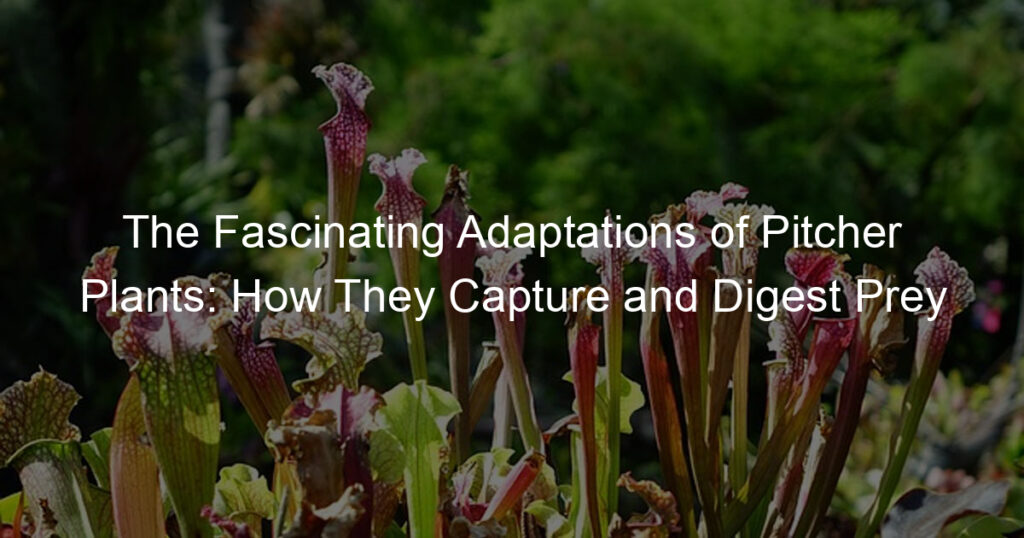Are you intrigued by the botanic world’s greatest oddities? If so, then pitcher plants are a must-see. These remarkable carnivorous plants possess an array of adaptations to help them not only survive in nutrient-deficient environments but also actively thrive. More impressively, they have evolved to “fish” for their food—trapping and digesting various invertebrates like flies, gnats, and spiders.
How do pitcher plants catch prey?
Pitcher plants are truly fascinating because of their unique adaptation to capture prey. All pitcher plants share the same underlying fundamentals – they use deep pitchers filled with digestive enzymes and nectar to entice insects.
When an insect lands inside, it slips on the steep walls and falls into the pool of enzyme-laden fluid at the bottom. Unable to escape, the enzyme will slowly break down and digest the unfortunate insect over several days before finally dissolving it away.
Talk about a grisly way for a plant to get its nutrients! However, this is just another example of nature’s efficient means of survival – pitcher plants can acquire food without ever having to move from their spot!
What is the structure of pitcher plants?
Pitcher plants are one of the wonders of the plant world put on this earth for us to marvel at. Their stunning structure consists of two parts – an upper trap, that has a hood-like lid above a bulbous shaped pouch with ‘teeth’ that line its edges and act as a slippery slope for insect prey, and a tube below the pouch which is filled with digestive fluids.
Making their home in wetlands, bogs, or tropical rainforests with nnutrient-poorsoil, these carnivorous plants rely on sucking up insects to survive instead of photosynthesizing sunlight for energy like most other plants do. Evolution has made sure they have all the tools necessary to survive off unsuspecting visitors to their live traps!
How do pitcher plants digest insects?
Pitcher plants are fascinating carnivorous plants that get the majority of their nutrients by digesting insects and invertebrates. They have deeply divided leaves that form tubes that act as entrapment chambers.
Insects enter through openings in the tubes and are unable to escape because they’re covered in downward-facing hairs. Once the insect is trapped, enzymes located on the walls within the tube break down the proteins and fats of the insect into smaller molecules that can be absorbed by the plant’s roots.
The pitcher plant then proceeds to use these molecules as a source of nutrition! While it may not sound like much, these adaptable plants have turned their unusual ability to digest insects into a thriving family of species found all over the world!
What adaptations do pitcher plants have?
Pitcher plants are fascinating carnivores that have evolved clever adaptations to capture their prey. They possess a deep pitcher-shaped tubular structure filled with liquid, which lures in insects attracted to the enticing nectar-like scent.
Once inside, the slippery rim of the tube and some fine hairs on their walls direct the unsuspecting victims to the bottom of the trap from where they cannot escape. The plants also secrete digestive enzymes into the pool to liquify the prey for immediate absorption by specialized cells called ‘lid epithelia’.
Additionally, these plants grow at lower light intensities than most other species and have adapted strategies to recycle nutrients retained within their pitchers thus providing limited but continuous sustenance throughout their lives. This is truly amazing considering they live mainly in nutrient-poor acidic bogs which would not be hospitable for other organisms.
What is the function of pitcher plant fluid?
Have you heard of pitcher plants? These plants have evolved some amazing features to help them survive – one of which is their pitcher-like structure involving special fluids.
Pitcher plant fluid is a combination of rainwater, secretions from the tube itself, and mashed-up insects! This liquid serves as an important trapping device for the plant, as it’s filled with enzymes that break down the insects floating in it and provide nutrients essential for the pitcher’s growth.
The fluid also plays a role in blocking out sunlight and preventing evaporation – allowing for efficient photosynthesis so the plant can grab maximum sunlight energy to fuel its survival. Amazingly, this liquid recipe has been perfected by Nature over thousands of years and is an incredible adaptation that gives pitcher plants an edge over others.
How do pitcher plants avoid self-digestion?
Many people find pitcher plants to be fascinating, and for good reason. These carnivorous plants not only produce amazing multi-colored blooms, but their unique way of capturing prey is equally interesting!
One remarkable fact about them is that these plants have developed a mechanism to avoid self-digestion when capturing prey. This is brought about by a secreting system that forms an inner wall that stops digestive enzymes from coming in contact with internal plant tissue.
By creating this barrier between its insides and the enzymes, pitcher plants can capture their prey without damaging themselves in the process. It’s truly quite amazing, and serves as another example of how wondrous nature can be!
Conclusion
Pitcher plants are fascinating creatures with remarkable adaptations for capturing and digesting prey. From the various trap structures to their specialized enzymes, these stunningly complex carnivorous plants provide us with an impressive example of nature’s ingenuity. Though they may seem alien-like in many ways, they truly exemplify the wonders of plant life on earth – a marvel everyone should take some time to appreciate.








